
One of the public service activities sponsored by the South Dakota Canoe/Kayak Association is an annual river clean-up. This year, the group took on a section of the Big Sioux River through Sioux Falls from the “put-in” near 57th Street and Western to the “take-out” at 26th Street and Southeastern Ave.
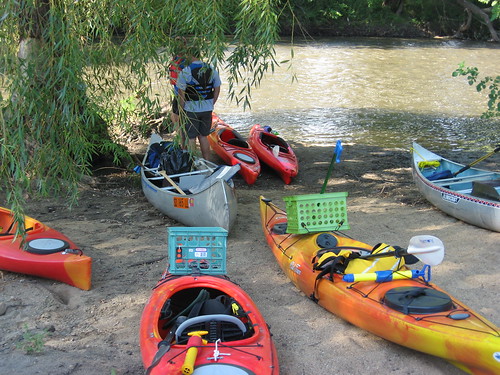
At 5:30 p.m. yesterday afternoon, about 18 paddlers with at least four canoes and ten or more kayaks assembled at the put-in and arranged a shuttle of vehicles downstream to the take-out. The general plan was to have the canoes move down the river functioning as “mother ships” with the fleet of kayaks picking up rubbish along the banks. In actual operation, though, the canoes were just as engaged in gathering debris as the kayak; in fact, the canoes were able to pick up large items that the kayaks just could not handle.
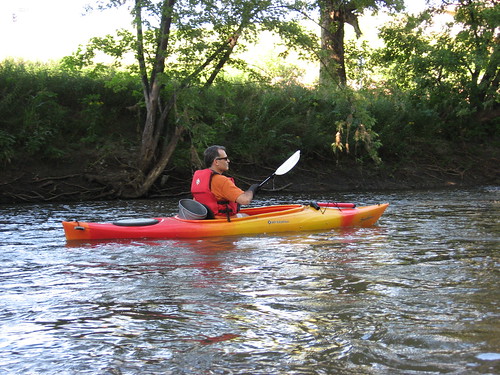
Some of the kayaks had milk crates strapped on the forward deck, while others had other types of containers to hold debris. Everyone had a supply of plastic garbage bags into which rubbish was stuffed. Sometimes the kayaks handed off materials to the canoes.

The river was still pretty high and running fast as we set out. The fast flow created an opportunity for paddlers to work on their maneuvering skills as they angled in to pick up plastic bottles, plastic bags, styrofoam, cardboard coffee cups, and other bits of trash. It was often a judgment call to risk a capsize or being caught up in a strainer in order to snag a discarded plastic soda bottle. The river was flowing so fast that it was often necessary to circle back and move upstream along the shore to retrieve a piece of debris.
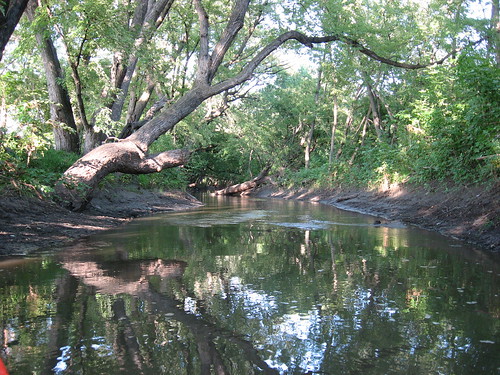
The boats moved out in a group and I wondered if there would be enough trash for so many boats. I was one of the first paddlers to move downstream and was able to gather the “low hanging fruit” at first. About fifteen minutes into the trip, I moved into a narrow channel that had created an island in the river. The stream I followed was deep enough to easily navigate, but I was alone. As I continued to move down this channel, I saw that no one had followed.
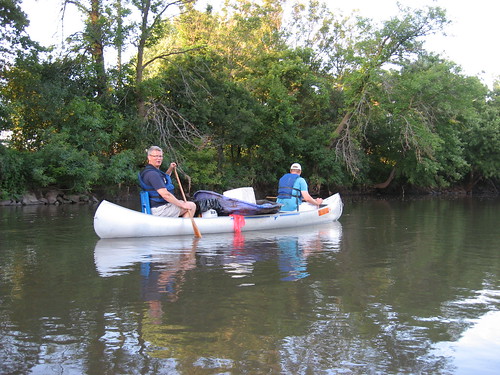
After about 15 minutes, I reentered the main course of the river and saw only one other boat, an aluminum canoe with two guys weighted down with some heavy debris, including a couple of long boards, most of a child’s wadding pool, and other items that made the canoe seem more like a barge.
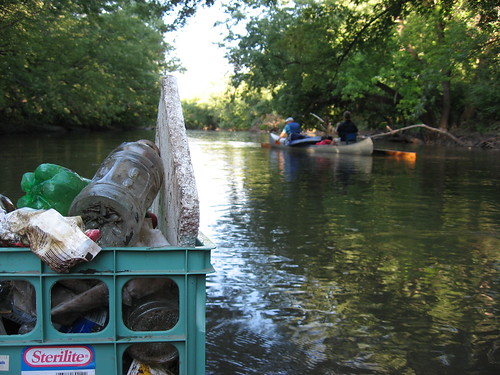
We two boats continued along the course of the river. I had no idea whether we were in the lead or in the rear; there was no sign of any of the other dozen boats. We both continued to load up our boats as we moved downstream. From the point where we encountered each other until the end, there was no sign of any other boat. It was as if we were alone on the river.
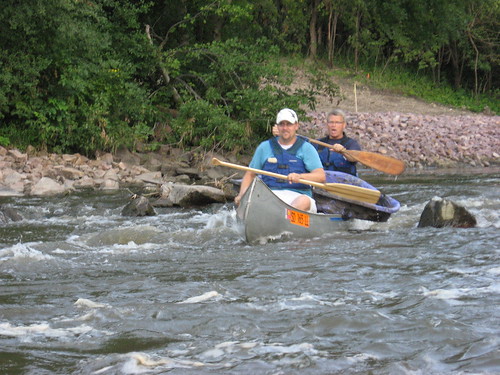
As we approached the rapids under the bicycle trail bridge, I could hear the water rushing over the rocks. My normal practice is to hang back and watch someone else go through the rapids first and, if they are successful, to follow their track. The guys in the canoe, however, wanted me to go first. The last time I came through this stretch, the water was so high that there was no sign of rapids. This time, though, it was different. I thought I recalled that it was best to head to the right side of the rapids, and this is what I did. As I was moving through, I saw rocks ahead and had to move between them. Later, David Finck told me that I took the wrong side; it would have been better to shoot through the center. But, I made it through and, so I heard, did all the other boats. I generally feel a little tense as I approach these rapids, even though I have never had a problem with them. The next time, I will try to follow my routine and observe someone else go through first and follow along in that pathway. There is a sense of exhilaration at shooting through these rapids, and we all hope that there will be spectators on the bridge to appreciate our skill and courage!
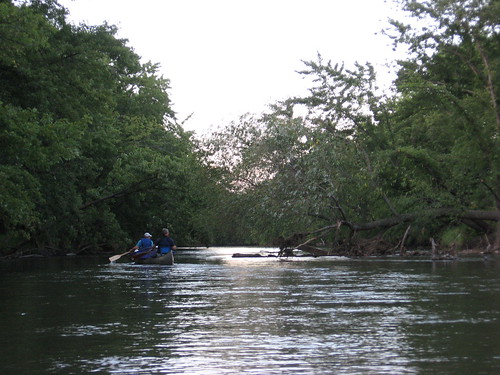
I understand that two of the kayaks capsized in waist-deep water when approaching a downed tree (strainer). A capsize would be easy with kayaks maneuvering to gather litter caught up along the shore or in strainers.
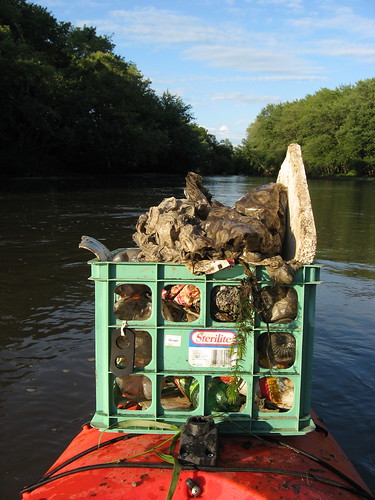
Also, the kayaks were loaded up with debris, making them more unwieldy.

When we got to the take-out, my canoeing companions and I were indeed the first boats in. Zach, of Zach’s Kayaks and Canoes, was at the landing to help pull the boats up. The bank at the take-out is muddy and steep. Someone to help people get their boats out is certainly welcome, and Zach was there! In fact, he contributed two canoes to the clean-up effort and stayed at the landing assisting people until we were all ashore. Zach told me, by the way, that this stretch of river that we paddled was the primer route selected by his clients.
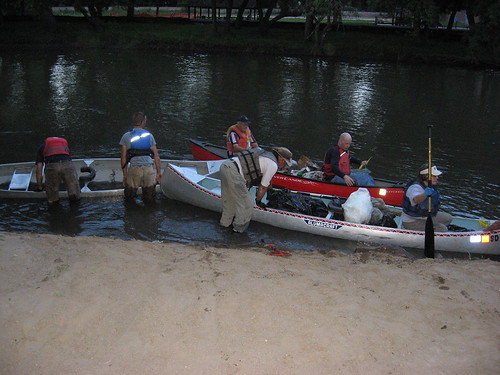
Within ten minutes or so, other boats began arriving with their load of rubbish. We created a large heap of debris, mostly more than twenty large garbage bags full of junk. The canoes had some larger items, including a television set. Someone picked up two pairs of tennis shoes tied together. A small bullhead was in one of the shoes, and I took him back to the river to live on a while longer.
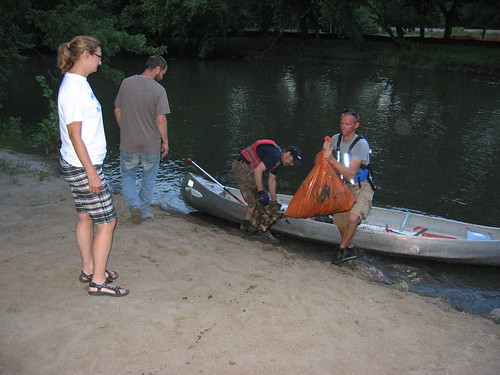
The last two kayaks arrived about 8:30 p.m. in the dark. We piled up the debris, took a group photo, and called it a good effort.
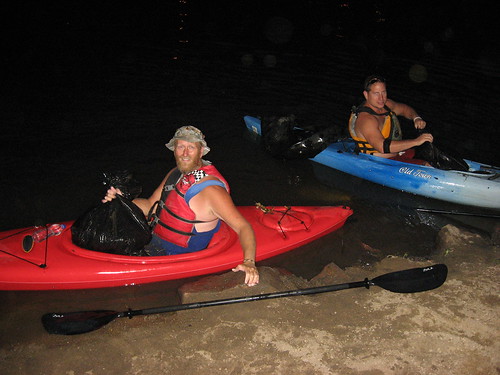
The last time the club did a Big Sioux River clean-up, there was one canoe and three kayaks involved. This year we had about 18 people and more than a dozen boats. I think that the large number of people turning up is an indication of the increasing popularity of kayaking in our area and the increasingly robust nature of the SDCKA.
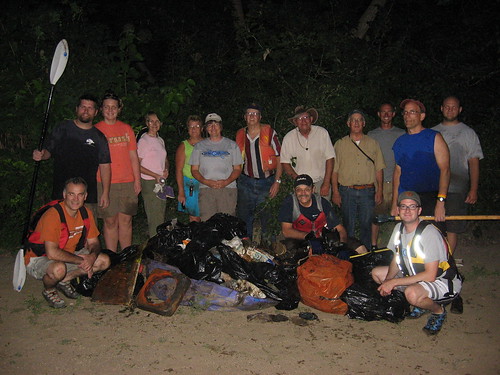

No comments:
Post a Comment